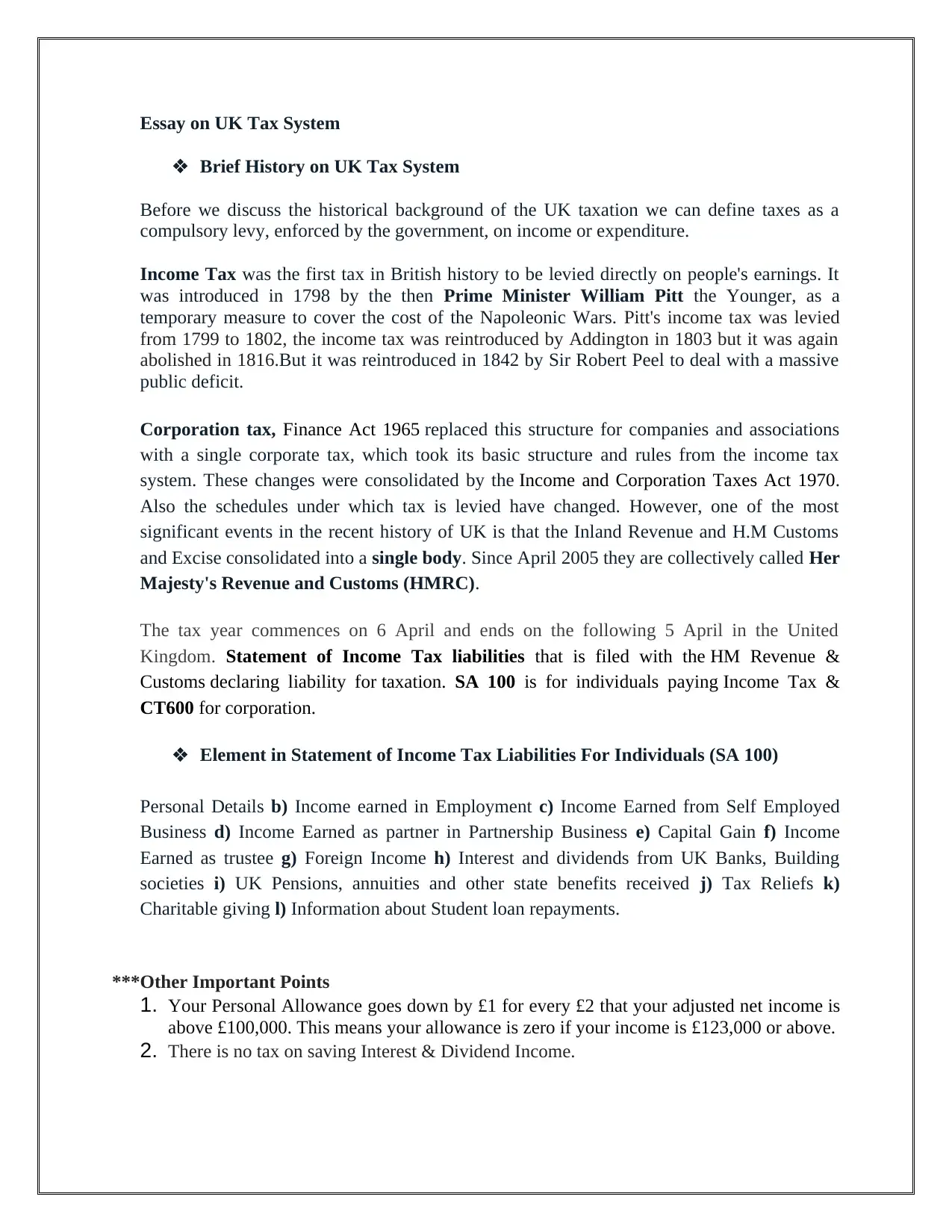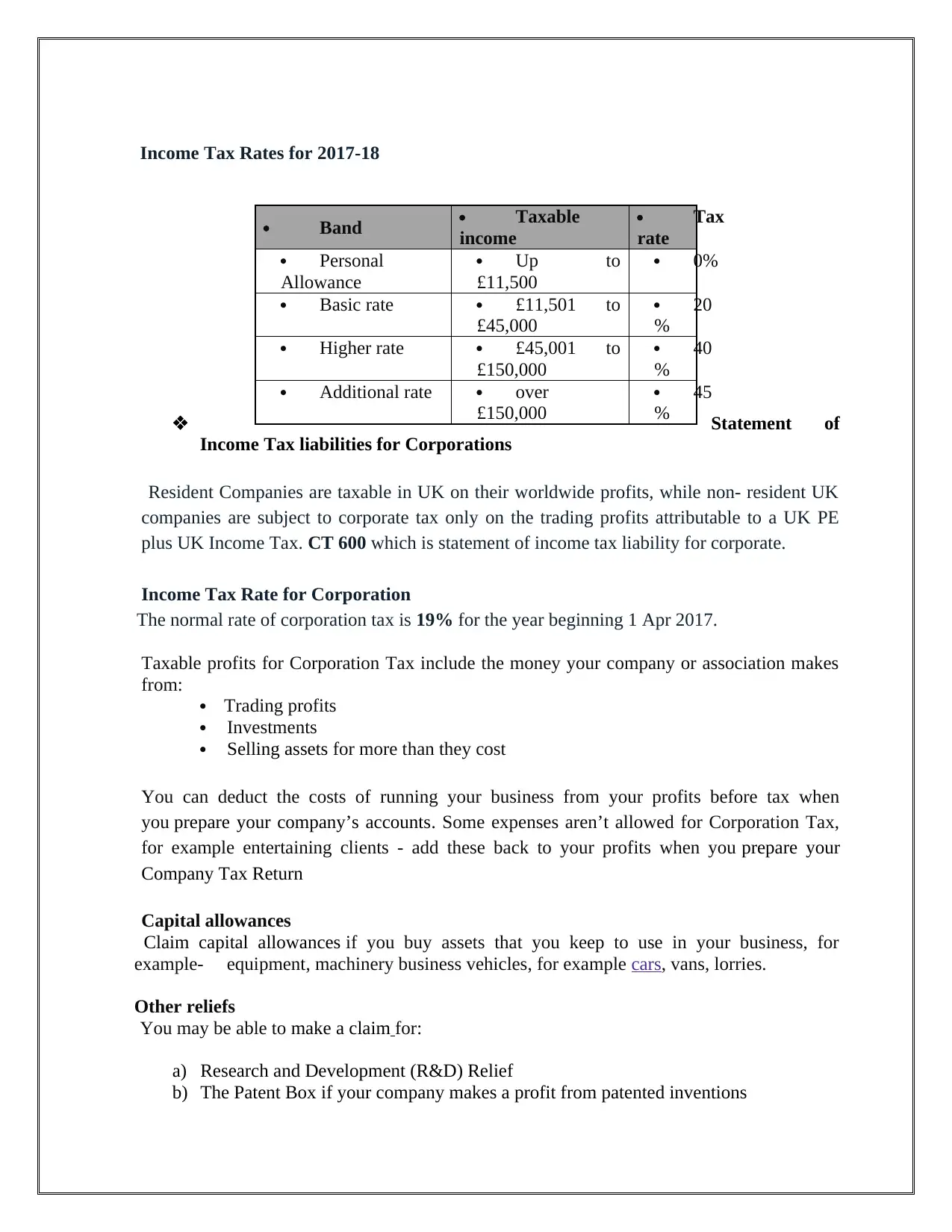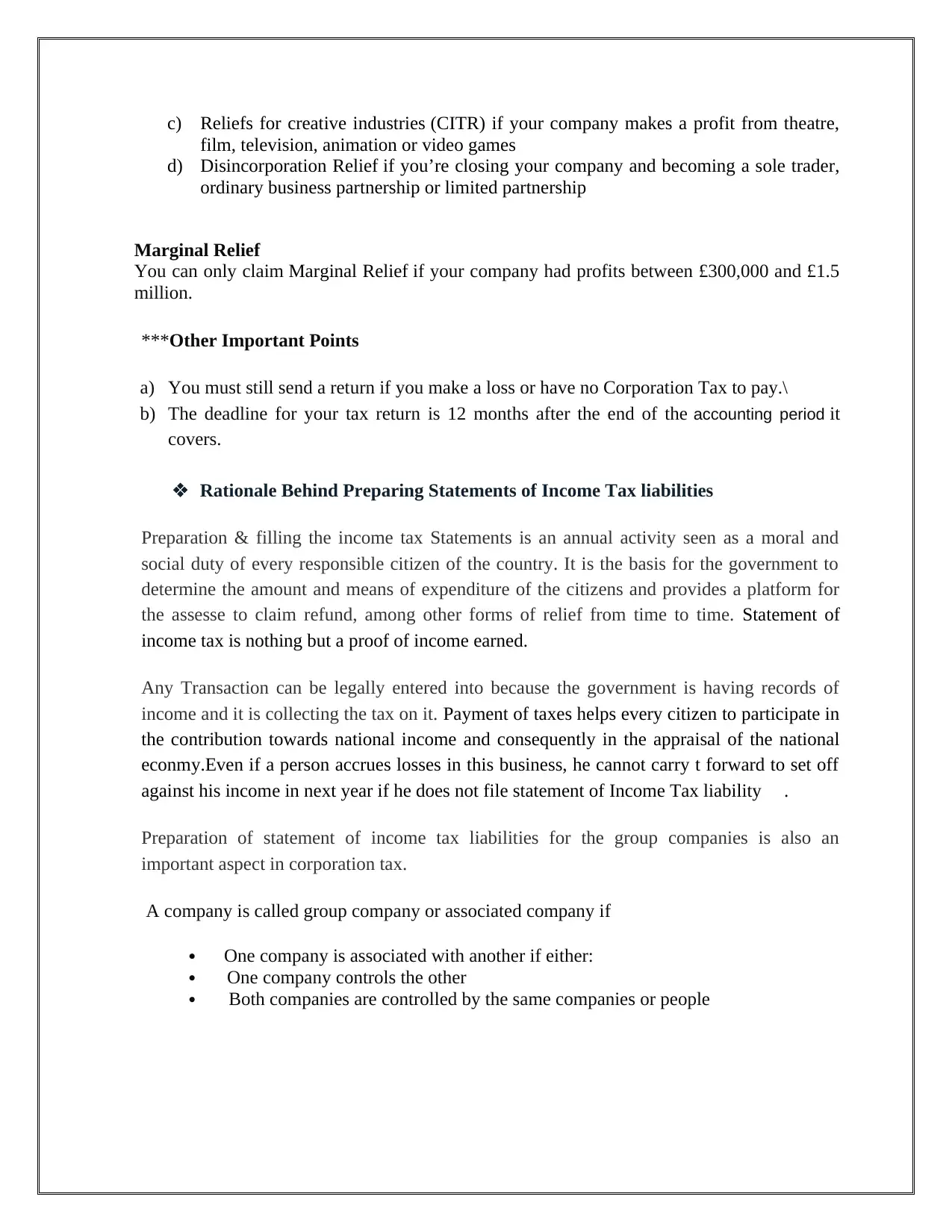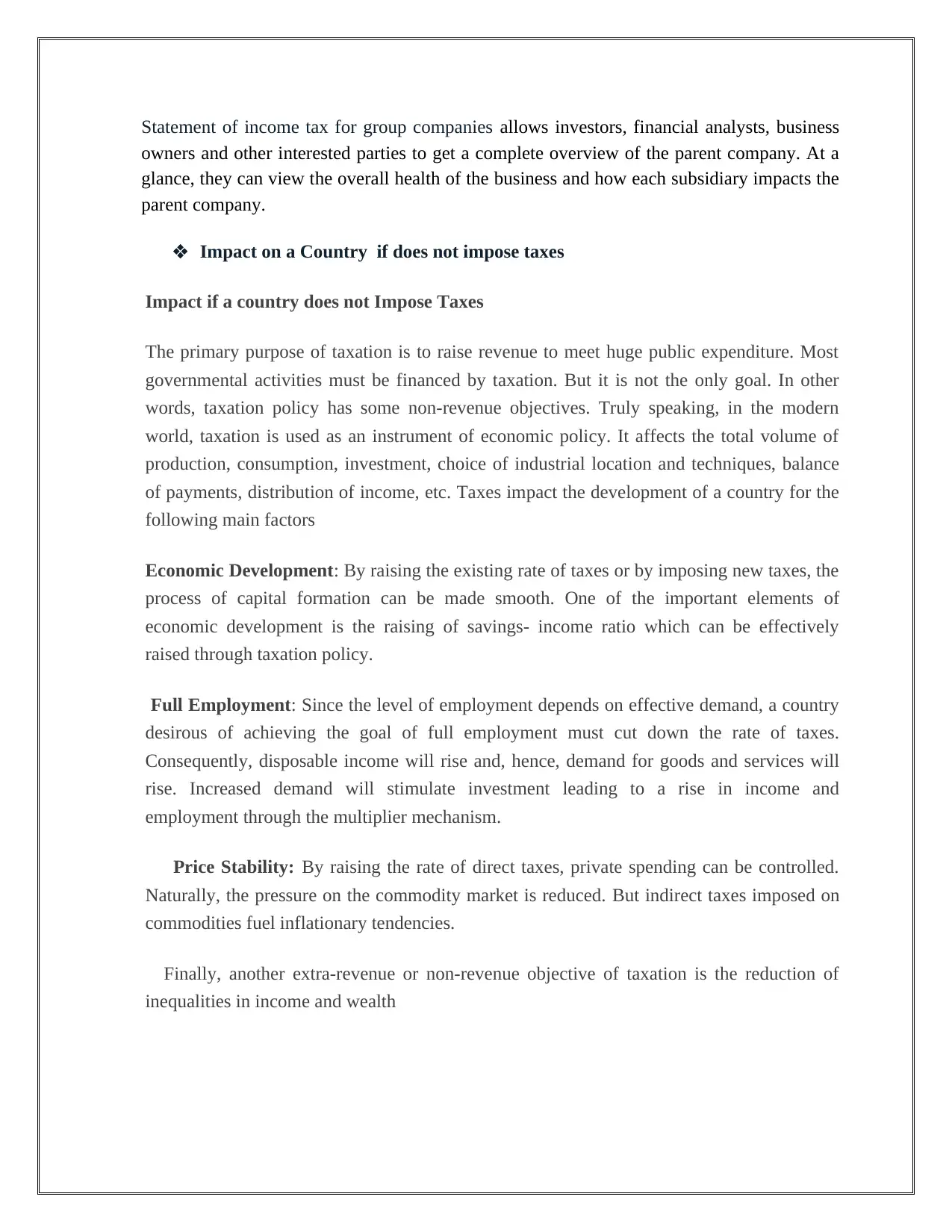UK Tax System Essay
VerifiedAdded on 2019/10/16
|4
|1347
|182
Essay
AI Summary
This essay provides a comprehensive overview of the UK tax system, starting with its historical background, including the introduction of income tax and corporation tax. It details the elements of income tax liabilities for individuals and corporations, including tax rates for different income bands and corporation tax rates. The essay also covers important aspects such as personal allowances, capital allowances, and various tax reliefs. Furthermore, it discusses the rationale behind preparing income tax statements, the impact of taxation on a country's economic development, and the consequences of not imposing taxes. The essay emphasizes the role of taxation in economic development, full employment, and price stability.

Essay on UK Tax System
Brief History on UK Tax System
Before we discuss the historical background of the UK taxation we can define taxes as a
compulsory levy, enforced by the government, on income or expenditure.
Income Tax was the first tax in British history to be levied directly on people's earnings. It
was introduced in 1798 by the then Prime Minister William Pitt the Younger, as a
temporary measure to cover the cost of the Napoleonic Wars. Pitt's income tax was levied
from 1799 to 1802, the income tax was reintroduced by Addington in 1803 but it was again
abolished in 1816.But it was reintroduced in 1842 by Sir Robert Peel to deal with a massive
public deficit.
Corporation tax, Finance Act 1965 replaced this structure for companies and associations
with a single corporate tax, which took its basic structure and rules from the income tax
system. These changes were consolidated by the Income and Corporation Taxes Act 1970.
Also the schedules under which tax is levied have changed. However, one of the most
significant events in the recent history of UK is that the Inland Revenue and H.M Customs
and Excise consolidated into a single body. Since April 2005 they are collectively called Her
Majesty's Revenue and Customs (HMRC).
The tax year commences on 6 April and ends on the following 5 April in the United
Kingdom. Statement of Income Tax liabilities that is filed with the HM Revenue &
Customs declaring liability for taxation. SA 100 is for individuals paying Income Tax &
CT600 for corporation.
Element in Statement of Income Tax Liabilities For Individuals (SA 100)
Personal Details b) Income earned in Employment c) Income Earned from Self Employed
Business d) Income Earned as partner in Partnership Business e) Capital Gain f) Income
Earned as trustee g) Foreign Income h) Interest and dividends from UK Banks, Building
societies i) UK Pensions, annuities and other state benefits received j) Tax Reliefs k)
Charitable giving l) Information about Student loan repayments.
***Other Important Points
1. Your Personal Allowance goes down by £1 for every £2 that your adjusted net income is
above £100,000. This means your allowance is zero if your income is £123,000 or above.
2. There is no tax on saving Interest & Dividend Income.
Brief History on UK Tax System
Before we discuss the historical background of the UK taxation we can define taxes as a
compulsory levy, enforced by the government, on income or expenditure.
Income Tax was the first tax in British history to be levied directly on people's earnings. It
was introduced in 1798 by the then Prime Minister William Pitt the Younger, as a
temporary measure to cover the cost of the Napoleonic Wars. Pitt's income tax was levied
from 1799 to 1802, the income tax was reintroduced by Addington in 1803 but it was again
abolished in 1816.But it was reintroduced in 1842 by Sir Robert Peel to deal with a massive
public deficit.
Corporation tax, Finance Act 1965 replaced this structure for companies and associations
with a single corporate tax, which took its basic structure and rules from the income tax
system. These changes were consolidated by the Income and Corporation Taxes Act 1970.
Also the schedules under which tax is levied have changed. However, one of the most
significant events in the recent history of UK is that the Inland Revenue and H.M Customs
and Excise consolidated into a single body. Since April 2005 they are collectively called Her
Majesty's Revenue and Customs (HMRC).
The tax year commences on 6 April and ends on the following 5 April in the United
Kingdom. Statement of Income Tax liabilities that is filed with the HM Revenue &
Customs declaring liability for taxation. SA 100 is for individuals paying Income Tax &
CT600 for corporation.
Element in Statement of Income Tax Liabilities For Individuals (SA 100)
Personal Details b) Income earned in Employment c) Income Earned from Self Employed
Business d) Income Earned as partner in Partnership Business e) Capital Gain f) Income
Earned as trustee g) Foreign Income h) Interest and dividends from UK Banks, Building
societies i) UK Pensions, annuities and other state benefits received j) Tax Reliefs k)
Charitable giving l) Information about Student loan repayments.
***Other Important Points
1. Your Personal Allowance goes down by £1 for every £2 that your adjusted net income is
above £100,000. This means your allowance is zero if your income is £123,000 or above.
2. There is no tax on saving Interest & Dividend Income.
Paraphrase This Document
Need a fresh take? Get an instant paraphrase of this document with our AI Paraphraser

Income Tax Rates for 2017-18
Statement of
Income Tax liabilities for Corporations
Resident Companies are taxable in UK on their worldwide profits, while non- resident UK
companies are subject to corporate tax only on the trading profits attributable to a UK PE
plus UK Income Tax. CT 600 which is statement of income tax liability for corporate.
Income Tax Rate for Corporation
The normal rate of corporation tax is 19% for the year beginning 1 Apr 2017.
Taxable profits for Corporation Tax include the money your company or association makes
from:
Trading profits
Investments
Selling assets for more than they cost
You can deduct the costs of running your business from your profits before tax when
you prepare your company’s accounts. Some expenses aren’t allowed for Corporation Tax,
for example entertaining clients - add these back to your profits when you prepare your
Company Tax Return
Capital allowances
Claim capital allowances if you buy assets that you keep to use in your business, for
example- equipment, machinery business vehicles, for example cars, vans, lorries.
Other reliefs
You may be able to make a claim for:
a) Research and Development (R&D) Relief
b) The Patent Box if your company makes a profit from patented inventions
Band Taxable
income
Tax
rate
Personal
Allowance
Up to
£11,500
0%
Basic rate £11,501 to
£45,000
20
%
Higher rate £45,001 to
£150,000
40
%
Additional rate over
£150,000
45
%
Statement of
Income Tax liabilities for Corporations
Resident Companies are taxable in UK on their worldwide profits, while non- resident UK
companies are subject to corporate tax only on the trading profits attributable to a UK PE
plus UK Income Tax. CT 600 which is statement of income tax liability for corporate.
Income Tax Rate for Corporation
The normal rate of corporation tax is 19% for the year beginning 1 Apr 2017.
Taxable profits for Corporation Tax include the money your company or association makes
from:
Trading profits
Investments
Selling assets for more than they cost
You can deduct the costs of running your business from your profits before tax when
you prepare your company’s accounts. Some expenses aren’t allowed for Corporation Tax,
for example entertaining clients - add these back to your profits when you prepare your
Company Tax Return
Capital allowances
Claim capital allowances if you buy assets that you keep to use in your business, for
example- equipment, machinery business vehicles, for example cars, vans, lorries.
Other reliefs
You may be able to make a claim for:
a) Research and Development (R&D) Relief
b) The Patent Box if your company makes a profit from patented inventions
Band Taxable
income
Tax
rate
Personal
Allowance
Up to
£11,500
0%
Basic rate £11,501 to
£45,000
20
%
Higher rate £45,001 to
£150,000
40
%
Additional rate over
£150,000
45
%

c) Reliefs for creative industries (CITR) if your company makes a profit from theatre,
film, television, animation or video games
d) Disincorporation Relief if you’re closing your company and becoming a sole trader,
ordinary business partnership or limited partnership
Marginal Relief
You can only claim Marginal Relief if your company had profits between £300,000 and £1.5
million.
***Other Important Points
a) You must still send a return if you make a loss or have no Corporation Tax to pay.\
b) The deadline for your tax return is 12 months after the end of the accounting period it
covers.
Rationale Behind Preparing Statements of Income Tax liabilities
Preparation & filling the income tax Statements is an annual activity seen as a moral and
social duty of every responsible citizen of the country. It is the basis for the government to
determine the amount and means of expenditure of the citizens and provides a platform for
the assesse to claim refund, among other forms of relief from time to time. Statement of
income tax is nothing but a proof of income earned.
Any Transaction can be legally entered into because the government is having records of
income and it is collecting the tax on it. Payment of taxes helps every citizen to participate in
the contribution towards national income and consequently in the appraisal of the national
econmy.Even if a person accrues losses in this business, he cannot carry t forward to set off
against his income in next year if he does not file statement of Income Tax liability .
Preparation of statement of income tax liabilities for the group companies is also an
important aspect in corporation tax.
A company is called group company or associated company if
One company is associated with another if either:
One company controls the other
Both companies are controlled by the same companies or people
film, television, animation or video games
d) Disincorporation Relief if you’re closing your company and becoming a sole trader,
ordinary business partnership or limited partnership
Marginal Relief
You can only claim Marginal Relief if your company had profits between £300,000 and £1.5
million.
***Other Important Points
a) You must still send a return if you make a loss or have no Corporation Tax to pay.\
b) The deadline for your tax return is 12 months after the end of the accounting period it
covers.
Rationale Behind Preparing Statements of Income Tax liabilities
Preparation & filling the income tax Statements is an annual activity seen as a moral and
social duty of every responsible citizen of the country. It is the basis for the government to
determine the amount and means of expenditure of the citizens and provides a platform for
the assesse to claim refund, among other forms of relief from time to time. Statement of
income tax is nothing but a proof of income earned.
Any Transaction can be legally entered into because the government is having records of
income and it is collecting the tax on it. Payment of taxes helps every citizen to participate in
the contribution towards national income and consequently in the appraisal of the national
econmy.Even if a person accrues losses in this business, he cannot carry t forward to set off
against his income in next year if he does not file statement of Income Tax liability .
Preparation of statement of income tax liabilities for the group companies is also an
important aspect in corporation tax.
A company is called group company or associated company if
One company is associated with another if either:
One company controls the other
Both companies are controlled by the same companies or people
⊘ This is a preview!⊘
Do you want full access?
Subscribe today to unlock all pages.

Trusted by 1+ million students worldwide

Statement of income tax for group companies allows investors, financial analysts, business
owners and other interested parties to get a complete overview of the parent company. At a
glance, they can view the overall health of the business and how each subsidiary impacts the
parent company.
Impact on a Country if does not impose taxes
Impact if a country does not Impose Taxes
The primary purpose of taxation is to raise revenue to meet huge public expenditure. Most
governmental activities must be financed by taxation. But it is not the only goal. In other
words, taxation policy has some non-revenue objectives. Truly speaking, in the modern
world, taxation is used as an instrument of economic policy. It affects the total volume of
production, consumption, investment, choice of industrial location and techniques, balance
of payments, distribution of income, etc. Taxes impact the development of a country for the
following main factors
Economic Development: By raising the existing rate of taxes or by imposing new taxes, the
process of capital formation can be made smooth. One of the important elements of
economic development is the raising of savings- income ratio which can be effectively
raised through taxation policy.
Full Employment: Since the level of employment depends on effective demand, a country
desirous of achieving the goal of full employment must cut down the rate of taxes.
Consequently, disposable income will rise and, hence, demand for goods and services will
rise. Increased demand will stimulate investment leading to a rise in income and
employment through the multiplier mechanism.
Price Stability: By raising the rate of direct taxes, private spending can be controlled.
Naturally, the pressure on the commodity market is reduced. But indirect taxes imposed on
commodities fuel inflationary tendencies.
Finally, another extra-revenue or non-revenue objective of taxation is the reduction of
inequalities in income and wealth
owners and other interested parties to get a complete overview of the parent company. At a
glance, they can view the overall health of the business and how each subsidiary impacts the
parent company.
Impact on a Country if does not impose taxes
Impact if a country does not Impose Taxes
The primary purpose of taxation is to raise revenue to meet huge public expenditure. Most
governmental activities must be financed by taxation. But it is not the only goal. In other
words, taxation policy has some non-revenue objectives. Truly speaking, in the modern
world, taxation is used as an instrument of economic policy. It affects the total volume of
production, consumption, investment, choice of industrial location and techniques, balance
of payments, distribution of income, etc. Taxes impact the development of a country for the
following main factors
Economic Development: By raising the existing rate of taxes or by imposing new taxes, the
process of capital formation can be made smooth. One of the important elements of
economic development is the raising of savings- income ratio which can be effectively
raised through taxation policy.
Full Employment: Since the level of employment depends on effective demand, a country
desirous of achieving the goal of full employment must cut down the rate of taxes.
Consequently, disposable income will rise and, hence, demand for goods and services will
rise. Increased demand will stimulate investment leading to a rise in income and
employment through the multiplier mechanism.
Price Stability: By raising the rate of direct taxes, private spending can be controlled.
Naturally, the pressure on the commodity market is reduced. But indirect taxes imposed on
commodities fuel inflationary tendencies.
Finally, another extra-revenue or non-revenue objective of taxation is the reduction of
inequalities in income and wealth
1 out of 4
Related Documents
Your All-in-One AI-Powered Toolkit for Academic Success.
+13062052269
info@desklib.com
Available 24*7 on WhatsApp / Email
![[object Object]](/_next/static/media/star-bottom.7253800d.svg)
Unlock your academic potential
Copyright © 2020–2025 A2Z Services. All Rights Reserved. Developed and managed by ZUCOL.





